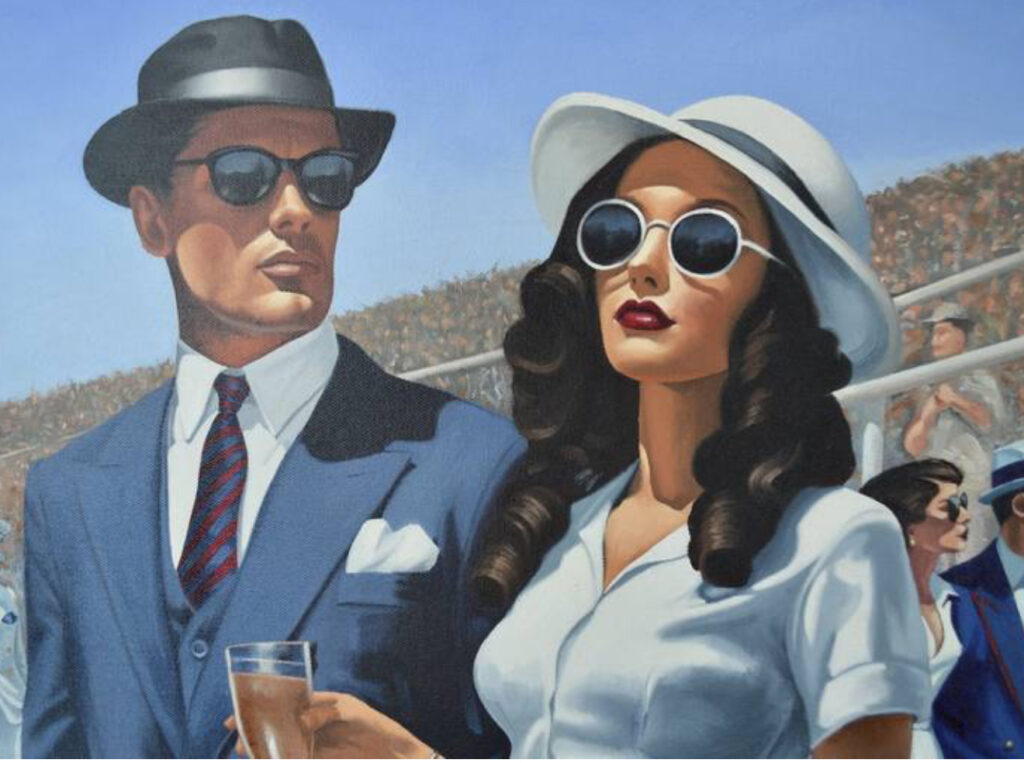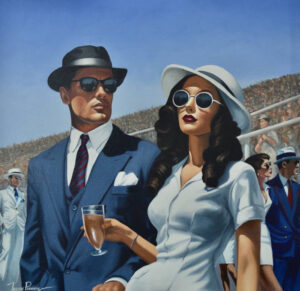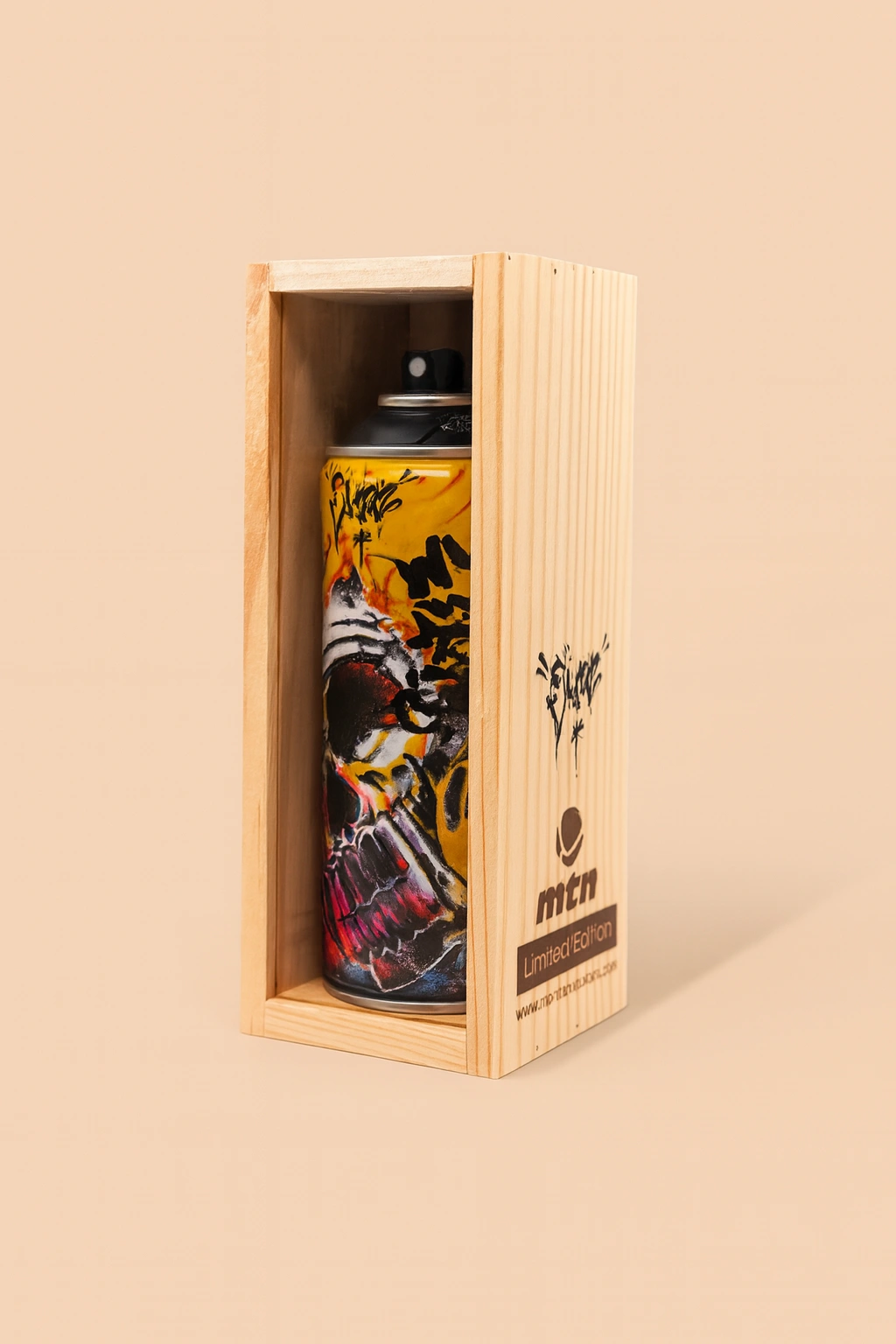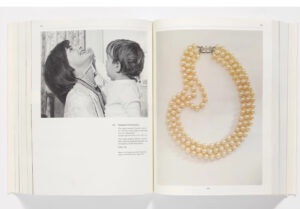In the pantheon of sporting events, few moments blend tradition, fashion, and theater like the Kentucky Derby. Often called “the fastest two minutes in sports,” the race is just one part of a wider cultural tableau—a festival of style, Southern charm, and high-stakes spectacle. In his oil painting titled Kentucky Derby, British artist Johnny Popkess brings this environment to life with striking realism and old-school glamour.
Rendered in oil on canvas, the painting evokes the golden era of race-day elegance, offering a cinematic portrayal of Derby culture. The central couple—flawless in posture and attire—are a tribute to mid-century Americana, despite the artist’s UK roots. Their poised expressions, tailored garments, and reflective sunglasses suggest affluence, allure, and a degree of distance from the commotion behind them. It’s a masterclass in character study, told without a single word.
This is more than a portrait of two people. It’s a visual exploration of identity, pageantry, and how we present ourselves when we know we’re being watched.
The Scene: Derby Day Decadence
At first glance, the painting is stunning for its compositional restraint. It doesn’t attempt to show the race or the horses. Instead, it zooms in on two elegantly dressed figures in the grandstand—he in a navy suit and fedora, she in a crisp white dress and wide-brimmed hat, both wearing dark sunglasses that reflect the midday sun. Behind them, the bleachers swell with the muted chaos of Derby spectators.
This isn’t an action shot. It’s a pause—a captured breath in the middle of a spectacle. That calm detachment makes the painting feel cinematic. It could be a film still from a 1960s drama, a promotional poster for a noir thriller, or a Vanity Fair feature on Derby fashion through the decades.
The Figures: Glamour in Stillness
Popkess’s couple are not named, but they don’t need to be. They exist as archetypes: confident, composed, untouchable. The man’s sharply cut suit, silk tie, and pressed pocket square suggest old money. The woman, with her dark waves, bold lipstick, and sculpted brows, channels both Grace Kelly and a touch of femme fatale. They could be celebrities, moguls, or characters plucked from a Fitzgerald novel.
Their sunglasses serve as both a fashion choice and a psychological barrier. We can’t see their eyes, and that makes them unreadable. We’re left wondering: are they enjoying the race? Themselves? Each other? The ambiguity is where the magic lives.
It’s a trick borrowed from photography and film—reflective lenses as a narrative device. Here, it reinforces the idea that these are people performing a role, aware of being observed, perhaps even by us.
The Technique: Smooth Realism Meets Stylized Design
Johnny Popkess works in a mode that could be called hyper-stylized realism. His brushwork is smooth, with almost photographic clarity, but his scenes are always slightly heightened. The light is cleaner than in life. The colors—especially the skin tones and sky—are more saturated than real-world hues. The effect is almost like an advertisement from the 1950s, or a polished fashion editorial.
In Kentucky Derby, Popkess uses contrast expertly: the dark sunglasses and suit lapels pop against the bright sky and the woman’s white hat. Their clothes are rendered with impeccable detail—creases, backgrounds, texture—while the background crowd is painted more loosely, intentionally out of focus. It creates a sense of visual depth and hierarchy. Our eyes go exactly where he wants them to: the couple, the moment, the myth.
Popkess’s Style: Retro, Cool, British—Yet Global
Johnny Popkess is based in the UK, but his aesthetic leans heavily into mid-century Americana. His work often depicts sharply dressed men and women in stylish standoffs or quiet tension, as if we’re eavesdropping on a private scene. Think Edward Hopper meets Slim Aarons with a dash of Mad Men.
This blending of British oil-painting tradition with American iconography gives his work an outsider’s clarity. He sees the Kentucky Derby not just as a sporting event but as a ritual of performance, akin to theater or high fashion. That lens allows him to abstract the race down to its most symbolic parts: not horses or trophies, but posture, costume, composure.
Cultural Commentary: The Derby as Stage
Popkess’s painting implicitly asks a question: What are we really celebrating at the Kentucky Derby?
Yes, there’s the race itself. But for many attendees and admirers, the Derby is more about social currency—who’s there, what they’re wearing, who they’re with. The couple in this painting aren’t watching the race. They’re embodying its aesthetic. They are the Derby. Their presence, style, and cool detachment are the real performance.
It’s a sly critique as much as it is a celebration. Popkess doesn’t mock his subjects, but he doesn’t sentimentalize them either. He captures them in all their glamorous complexity.
Symbolism and Subtext: Eyes, Hats, and Distance
There’s a lot of symbolic weight packed into this single scene:
- Sunglasses obscure the soul, protecting the characters while keeping us out.
- Hats, iconic at the Derby, signify both elegance and spectacle, tradition and individuality.
- The glass in the man’s hand (a mint julep?) hints at indulgence, leisure, maybe excess.
And then there’s the distance—emotional and physical. The couple may be together, but they’re not connected. Their bodies face forward, not toward each other. It’s possible they’re strangers. Or it’s possible that, like the Derby itself, their relationship is more about image than intimacy.
Popkess never resolves the tension. That’s the beauty.
Medium and Materials: Oil on Linen, Luxury in Every Layer
The painting is executed in oil on stretched linen canvas, measuring roughly 51 cm x 51 cm. Popkess uses premium materials—artist-grade oils, lightfast pigments, and a satin varnish—to achieve lasting vibrancy and finish. The linen texture allows for detailed brush control, giving the painting its signature sleek surface without visible brush marks.
It’s a modern piece with old-world craft—a rare balance in contemporary art.
Collector Appeal: Why It Resonates
Popkess’s Kentucky Derby appeals to a broad range of collectors:
- Fashion enthusiasts see it as a nod to vintage elegance and timeless style.
- Art collectors admire the execution and thematic sophistication.
- Equestrian fans and Derby aficionados recognize it as a love letter to an iconic cultural ritual.
- Mid-century lovers and retro-modern decorators see it as a centerpiece—one that tells a story without saying a word.
A Painting That Races Without Moving
In Kentucky Derby, Johnny Popkess doesn’t just depict a race day—he distills it. He compresses its fashion, spectacle, and quiet tension into a single, cinematic image. The couple in the painting could be anyone—or everyone. They are dressed to impress, poised to perform, and ultimately, frozen in a moment more permanent than the fleeting gallop of horses.
Through controlled brushwork, evocative styling, and cultural intelligence, Popkess delivers more than a portrait. He gives us a lens into identity, aspiration, and the complex dance between who we are and who we want to be.
No comments yet.









